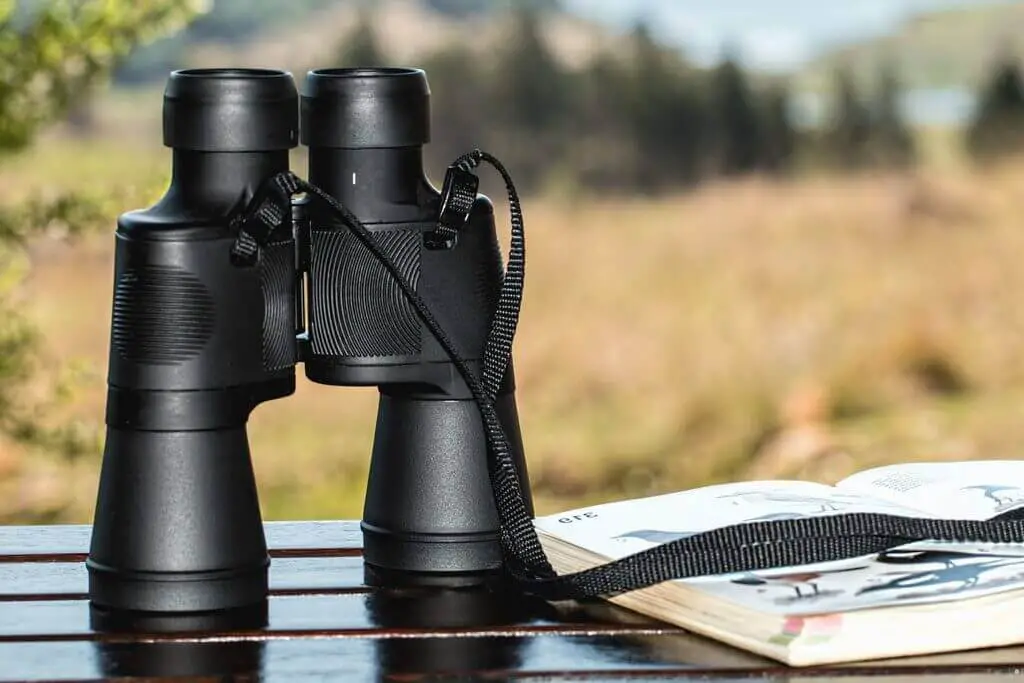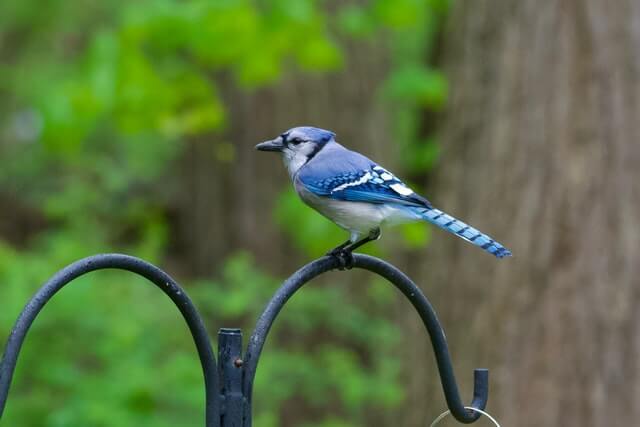Embark on a captivating journey through North Dakota’s diverse birding landscape with our comprehensive guide. This Ultimate Guide highlights the 37 most common birds found throughout the Peace Garden State, offering insightful details on their habitats, behaviors, and unique attributes.
Whether you’re an avid birdwatcher, a nature enthusiast, or simply curious about North Dakota’s rich birdlife, this guide provides a fascinating glimpse into the avian diversity that enriches this scenic state.
Table of Contents
- 1 Most Common Birds in North Dakota
- 1.1 American Robin
- 1.2 Mourning Dove
- 1.3 Red-winged Blackbird
- 1.4 Common Grackle
- 1.5 Black-capped Chickadee
- 1.6 American Goldfinch
- 1.7 House Sparrow
- 1.8 Western Meadowlark
- 1.9 American Crow
- 1.10 Song Sparrow
- 1.11 White-breasted Nuthatch
- 1.12 Brown-headed Cowbird
- 1.13 Downy Woodpecker
- 1.14 Yellow Warbler
- 1.15 European Starling
- 1.16 Northern Flicker
- 1.17 Blue Jay
- 1.18 House Finch
- 1.19 Eastern Kingbird
- 1.20 Hairy Woodpecker
- 1.21 Dark-eyed Junco
- 2 Author
Most Common Birds in North Dakota
American Robin
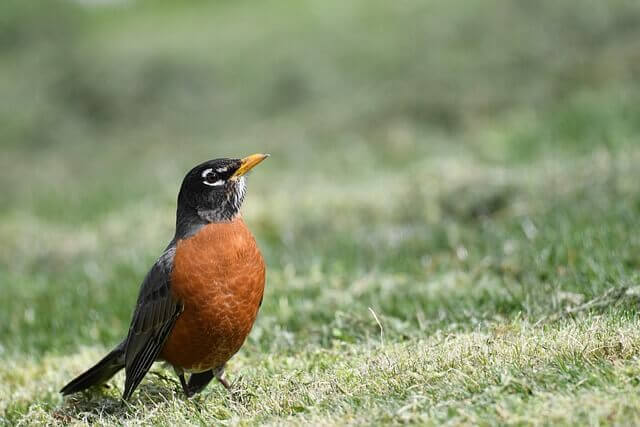
The American Robin is a type of bird that lives in North America. They are the most common species of robin and can be found from coast to coast. Robins have an extensive range, which includes almost all of Canada, all but two states in the United States (Alaska and Hawaii), as well as Central America and South America. Robins live in habitats such as forests, deserts, mountains, farmlands and suburban areas.
These birds can be found at various times throughout the year in different parts of North Dakota including in spring, summer, autumn, and winter. The robins fly south from their breeding grounds in Mexico to spend winter in a few areas, but they return again in spring to spend the winter in North America.
- Frequency: 40.89%
- Color: Mostly brown on the back with an orange colored breast
- Habitat: Wooded areas, backyards, parks, fields
- Range: USA, Canada, Mexico
- Size: 12-16″ inches in length
- Weight: 72-95 grams
- Diet: Fruits, berries and insects (earthworms, beetles, caterpillars
- Family: Turdidae
- Genus: Turdus
- Map: Range Map
- Sounds: Calls and Sounds
Related Post:
Mourning Dove
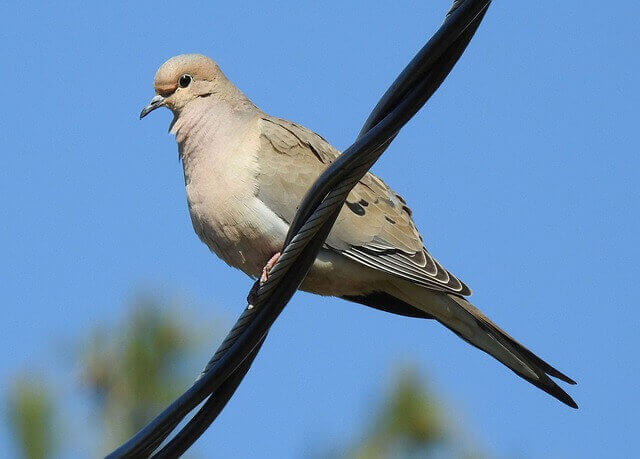
The Mourning dove is a small and abundant bird in North America. It’s found from the east coast to the west coast of the United States, with populations also located in Canada, Mexico and Central America. They can be seen year-round in parts of Texas, Florida and Arizona, but will migrate south for winter elsewhere.
Mourning doves eat almost anything that they find on the ground such as seeds, grain or insects which they may glean from beneath trees or shrubs where they forage. They will also eat some berries and leaves.
- Frequency: 33.59%
- Color: Light gray-brown and lighter and pinkish below. The wings have black spots.
- Habitat: Open habitats, urban areas, farms, prairie, grassland, wooded area
- Range: USA, Canada, Mexico, Central America, Greater Antilles
- Size: 12″ inches length
- Weight: 112 – 170 grams
- Diet: Rapeseed, corn, millet, safflower, sunflower seeds, pokeberry, sesame, and wheat.
- Family: Columbidae
- Genus: Zenaida
- Map: Range Map
- Sounds: Calls and Sounds
Related Posts: 10 Facts about Mourning Doves
Red-winged Blackbird

Red-winged Blackbirds are a migratory bird that ranges from Canada to northern Mexico. They breed in open habitats such as grasslands, wetlands and agricultural fields. During the winter months they can be found in areas with tall vegetation and water sources such as swamps, lakes or rivers.
During breeding season their diet consists of insects and other invertebrates, while during the winter months they eat seeds, nuts, berries and grain crops. Their migration pattern is primarily driven by temperature changes.
- Frequency: 33.21%
- Color: All black with red patches on shoulder and a yellow wing bar
- Habitat: Deciduous forests, conifers, roadside, rivers, backyards, parks
- Range: North America, Central America
- Size: 6.7 – 7.1″ inches length
- Weight: 41.5 – 65 grams
- Diet: Seeds and insects (butterflies, dragonflies, moths, frogs, worms, spider, snails, carrion, flies.)
- Family: Icteridae
- Genus: Agelaius
- Map: Range Map
- Sounds: Calls and Sounds
Common Grackle
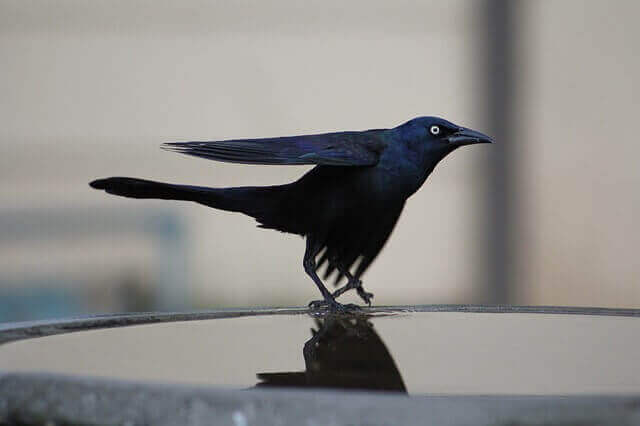
Common Grackles are birds of the order Passeriformes and family Icteridae. They can be found throughout North America, Central America, South America, and Cuba. Their habitat is in woodlands, forest edges, shrubby areas with bushes or small trees, suburban areas (in search of food), agricultural fields where they forage for grain and insects during the summer months when food sources are scarce due to nesting activities.
Grackles feed on insects such as grasshoppers, beetles and ants that they find while searching through leaves or soil; however they also eat seeds and berries that have fallen to the ground.
- Frequency: 28.96%
- Color: Black overall with a blue, and purple iridescence. Its body plumage is a shimmering copper color.
- Habitat: Woodlands, marshes, meadows, parks, backyards and fields
- Range: East of the Canadian Rockies, Canada and the United States
- Size: 11 – 13″ inches length
- Weight: 75 – 143 grams
- Diet: minnows, eggs, berries, seeds, grain, insects, frogs, mice
- Family: Icteridae
- Genus: Quiscalus
- Map: Range Map
- Sounds: Calls and Sounds
Black-capped Chickadee
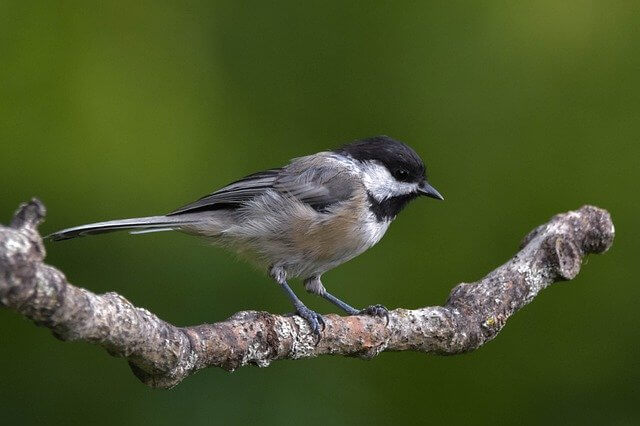
The black-capped chickadee is a small songbird found in North America. The black-capped chickadee lives from Alaska to Newfoundland and south to northern Mexico, with an eastern limit of the Appalachian Mountains.
This bird prefers deciduous woodlands near water sources for habitat, and its diet consists mainly of insects in summer and berries in winter. Migration occurs annually between breeding areas north of 40°N latitude and wintering grounds south of it.
- Frequency: 26.81%
- Color: Black cap, white on face, white/reddish-brown flanks
- Habitat: Deciduous and mixed forests, backyards, parks
- Range: USA and Canada
- Size: 11.5 -16 cm length
- Weight: 8 – 15 grams
- Diet: Insects, seeds, berries
- Family: Paridae
- Genus: Poecile
- Map: Range Map
- Sounds: Calls and Sounds
Related Post: How Do I Attract Chickadees To My Yard?
American Goldfinch
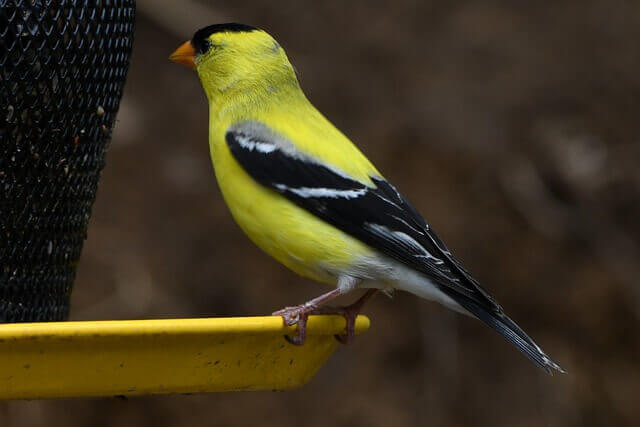
The American Goldfinch is a small, yellow bird found throughout North America. They are often seen in gardens and feeders during the winter months. Their range includes most of Canada and all the United States except for Florida and Hawaii.
The habitat they prefer includes meadows, open woodland, scrubland, brushy areas with trees or hedges for nesting sites as well as agricultural fields that have been recently harvested but not yet plowed under. In summer, they feed on insects, spiders and fruit; during the winter months they rely mainly on seeds.
- Frequency: 25.63%
- Color: Face, neck, and underside are yellow, black wings with white bars
- Habitat: Deciduous forests and thickets, roadside, grasslands, backyards, meadows
- Range: Canada, USA and Mexico
- Size: 4.3 – 5.5″ inches length
- Weight: 12 -18 grams
- Diet: Grass, dandelions, chickweed, sunflowers and ragweed, thistle, red alder, birch, spruce seeds
- Family: Carduelinae
- Genus: Spinus
- Map: Range Map
- Sounds: Calls and Sounds
Related Post: American Goldfinch Interesting Facts
House Sparrow
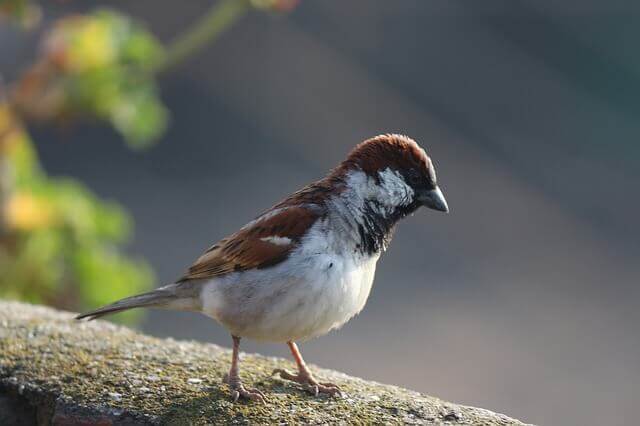
The House Sparrows are medium-sized birds that live in both urban and rural areas. They have a brown, streaked head with a white chest and belly. These birds can be found throughout the world in Europe, Asia, Africa, North America and Australia.
The habitat of these sparrows ranges from deserts to high altitudes. These birds eat seeds as well as insects like ants or beetles, depending on what is available in their environment. House Sparrows also migrate during the winter months.
- Frequency: 23.78%
- Color: Gray head marking, a reddish-brown back, and gray underparts
- Habitat: Urban centers, suburban areas, backyards, edges, yards, and parks
- Range: North America, Central America, South America, Africa, Australia, New Zealand
- Size: 5.5 – 7.1″ inches in length
- Weight: 25 – 39 grams
- Diet: Insects, beetles, caterpillars, aphids,, grasshoppers, crustaceans, earthworms, vertebrates
- Family: Passeridea
- Genus: Passer
- Map: Range Map
- Sounds: Calls and Sounds
Related Post: How to Attract Sparrows to your Backyard
Western Meadowlark
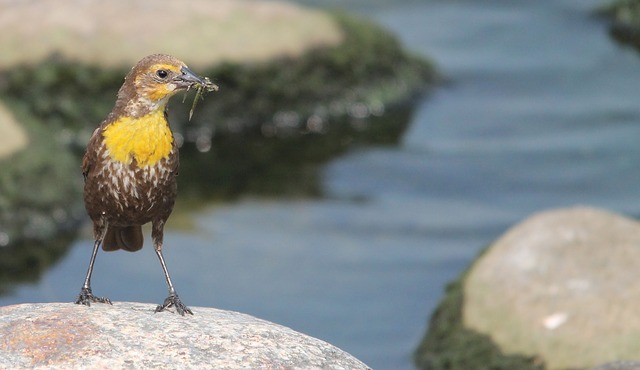
The western meadowlark is a migratory bird found in North America. It has been known to range from the southwestern United States to central Canada and as far south as Guatemala. The habitat for this bird is typically an open area such as meadows, prairies, pastures or farmland.
The diet of this species consists mainly of insects, but they will also eat seeds, berries and other small animals when available. Western meadowlarks are long-distance migrants that typically travel about 500 miles per day during their fall migration northward; some have been tracked migrating over 1,500 miles in one day.
- Frequency: 23.69%
- Color: Mostly brown upper with black streaks and yellow underparts
- Habitat: Pastures, prairies, grasslands, and fields,
- Range: Western and central North America
- Size: 8.5″ inches in length
- Weight: 90 – 115 grams
- Diet: Bugs, seeds, berries
- Family: Icteridae
- Genus: Sturnella
- Map: Range Map
- Sounds: Calls and Sounds
American Crow
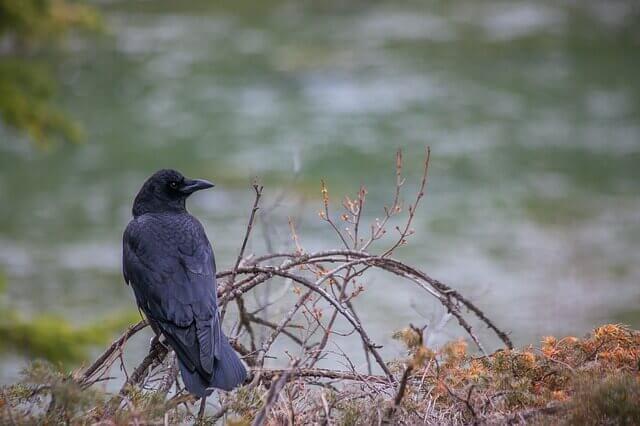
The American Crow is the most common and widespread bird species in North America. This avian predator primarily feeds on small mammals, invertebrates, carrion, berries and grains. The range of this species extends from Canada to northern Mexico, with some populations reaching Central America.
There are two types of migrations that occur for this species: short-distance migration which occurs during winter months when temperatures are low and long-distance migration which occurs in late summer to early fall when there is less availability of food.
- Frequency: 21.56%
- Color: Black
- Habitat: Open country, farms, parks, woodlands, towns, cities
- Range: Canada, USA, Mexico
- Size: 16 – 21″ inches in length
- Weight: 315 -620 grams
- Diet: invertebrates, carrion, seeds, eggs fish, grains, mice, frogs, and other small animals.
- Family: Corvidae
- Genus: Corvis
- Map: Range Map
- Sounds: Calls and Sounds
Related Posts:
Song Sparrow
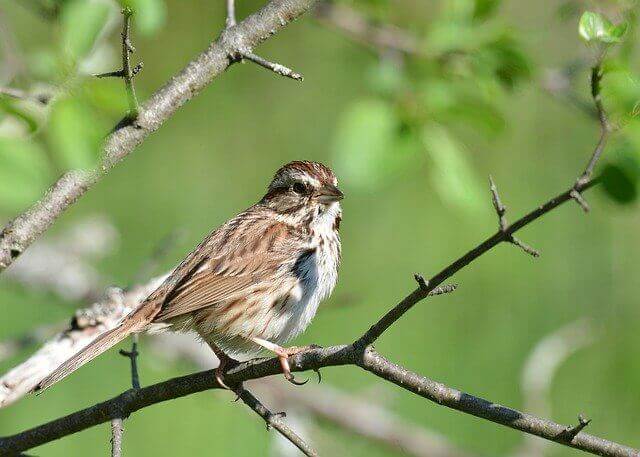
The Song Sparrow is a small, common and widespread songbird. The range of the species stretches from the Rocky Mountains to the Atlantic Ocean. It prefers open country with dense undergrowth and low shrubs, including marshes, bogs, thickets and forests. It eats insects like ants, beetles, flies and moths as well as seeds from grasses like rye-grass. Not only that, but it can also eat fruit if it’s available.
The song sparrow’s migration pattern starts when they start to migrate in the fall months before winter hits which are typically late September through early November.
- Frequency: 20.46%
- Color: Gray head, white cheek, a black bib, rufous neck
- Habitat: Urban centres, farms, backyards, edges, yards, and parks
- Range: Europe, Mediterranean, Asia, Australasia, Africa, and the Americas
- Size: 5.5 – 7.0″ inches in length
- Weight: 25 – 40 grams
- Diet: Grains, seeds and insects
- Family: Passeridea
- Genus: Passer
- Map: Range Map
- Sounds: Calls and Sounds
White-breasted Nuthatch

White-breasted Nuthatches are abundant species in North America. Their range extends from southern Ontario and the northern portion of Michigan to the lower Mississippi River and into the southern panhandle of Texas and into the Rocky Mountains of Colorado and Wyoming.
The birds are also found from south-central New Mexico into northern Arizona and western Nevada. They will often take over even an abandoned farm or cabin. The best time to spot a white-breasted nuthatch in North Dakota is between May and September.
- Frequency: 19.37%
- Color: White face, flanks and chest. It has a black cap on it’s head a bluish gray upper and brown lower belly
- Habitat: Deciduous forests, conifers, roadside, rivers, backyards, parks
- Range: Southern Canada, USA
- Size: 5.9″ inches in length
- Weight: 20 grams
- Diet: Acorn nuts, hickory nuts, ants, caterpillars, scale insects, pine weevils
- Family: Sittidae
- Genus: Sitta
- Map: Range Map
- Sounds: Calls and Sounds
Related Post: How to Attract Nuthatches to your Backyard?
Brown-headed Cowbird
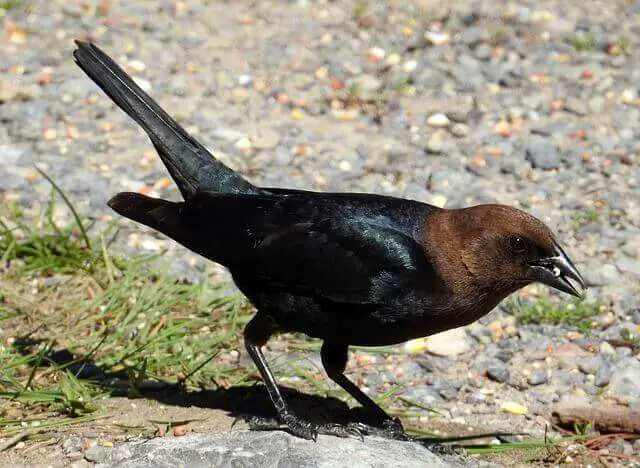
The Brown-headed Cowbird is a common bird of the United States. They are found in all states east of the Rocky Mountains, except for Maine and Minnesota. This species ranges from eastern Alaska to Texas, north into Canada and south into Mexico.
Brown-headed Cowbirds can be found in a variety of habitats including meadows, forests, marshes and shrublands; as well as parks or gardens near human settlements. They primarily eat insects and seeds, but will also feed on berries. This bird is known to migrate north in the summer months for breeding season before migrating south during winter months.
- Frequency: 18.59%
- Color: Iridescent black plumage and has a brown head
- Habitat: Forest edges, backyards, parks, suburban bird feeders
- Size: 6.3 – 8.7″ inches in length
- Weight: 30 – 60 grams
- Diet: Seeds and insects (grasshoppers, beetles, spiders)
- Family: Icteridae
- Genus: Mater
- Map: Range Map
- Sounds: Calls and Sounds
Downy Woodpecker

The Downy Woodpeckers are small birds that can be found in North America. They are the smallest woodpecker in North America and live year-round throughout the continent, except for a few areas on the east coast. Their diet consists of insects, spiders, nuts and seeds.
The Downy Woodpeckers range across most of North America, with exception to parts of eastern United States and Canada. They have a wide range of habitats, including suburbs and cities, coastal forests, mountain ranges and deserts.
- Frequency: 18.09%
- Color: Black with a white throat, belly, and back. White spots on wings
- Habitat: Deciduous forests and thickets, roadside, grasslands, backyards, parks
- Range: Canada, USA, and Mexico
- Size: 5.5 – 7.1″ inches in length
- Weight: 20 – 33 grams
- Diet: Mostly insects and beetles and ants, also gall wasps, caterpillars
- Family: Picadae
- Genus: Dryobates
- Map: Range Map
- Sounds: Calls and Sounds
Related Post:
Yellow Warbler
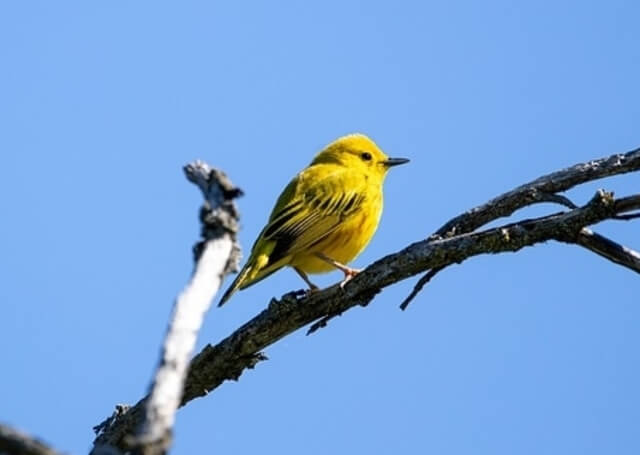
The Yellow Warblers are small songbirds that belong to the New World warbler family. They are found in Canada, the United States and Central America. Their habitat is usually in forests or shrubs near water sources. The diet of these birds includes insects, berries and nectar from flowers.
These birds migrate during winter months by flying south to warmer climates like South America and Mexico for food resources that aren’t available during this time of year back home in North America.
- Frequency: 16.78%
- Color: Greenish-yellow upper and are a duller yellow underside
- Habitat: marshes, swamps, streams, thickets, orchards, farmlands, forest edges, backyards
- Range: North America, Central America, South America
- Size: 4.0 – 7.0″ inches
- Weight: 7 – 25 grams
- Diet: caterpillars, mayflies, moths, mosquitoes, beetles, damselflies, treehoppers, spiders, berries.
- Family: Parulidae
- Genus: Setophaga
- Map: Range Map
- Sounds: Calls and Sounds
Related Post: How to Attract Yellow Warblers to your Backyard
European Starling
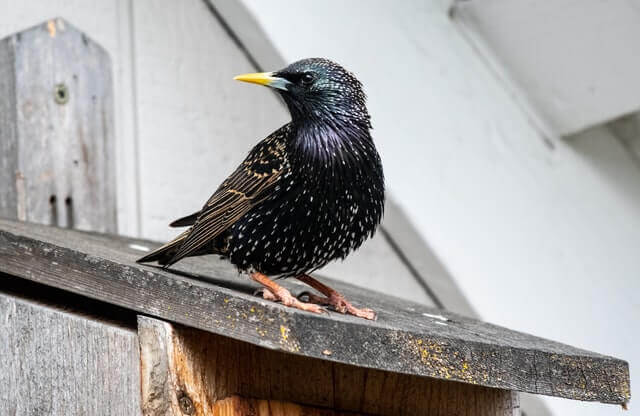
The European Starlings are a non-native species of bird that were introduced to North America in the late 1800s. These birds can be found throughout the United States and Canada, but their population is most dense in Eastern North America. The common habitats for these birds include forests, wetlands, and agricultural fields.
They eat mostly fruit, but will also consume insects, nuts, seeds and occasionally small mammals or reptiles. The starling’s diet varies depending on the time of year and what is available at that time. European Starlings migrate south during winter months when food sources are scarce and fly back north as soon as warmer weather arrives.
- Frequency: 16.54%
- Color: Black with glossy iridescence plumage
- Habitat: Forests, woodlands, backyards, edges, yards, and parks
- Range: North America, Europe, Africa, India, Middle East, China
- Size: 7 – 9″ inches long
- Weight: 60 – 100 grams
- Diet: Insects (ants, beetles, invertebrates), fruits, seeds, berries
- Family: Picadae
- Genus: Colaptes
- Map: Range Map
- Sounds: Calls and Sounds
Related Post: How to Attract European Starling to your yard?
Northern Flicker
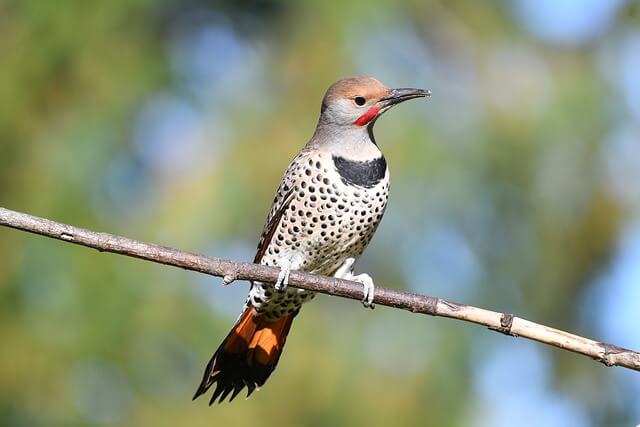
The Northern Flickers are members of the woodpecker family. They inhabit much of North America, Europe and Asia. The Northern Flicker has a range that stretches from Alaska to southern South America. It is found in both deciduous and coniferous forests. The Northern Flicker diet consists mainly of insects but also includes nuts, seeds, berries and fruits as well as eggs or nestlings of other birds.
They have been known to feed on dead animals, such as roadkill. The birds migrate in late summer or early fall by following forested routes northward to their wintering grounds.
- Frequency: 15.78%
- Color: Light brown with black bars across back, chest, wings, belly
- Habitat: Forests, woodlands, backyards, edges, yards, and parks
- Range: North America, Central America, Cuba, Cayman Islands
- Size: 10 – 14″ inches
- Weight: 85 – 165 grams
- Diet: Insects (ants, beetles, invertebrates), fruits, seeds, berries
- Family: Picadae
- Genus: Colaptes
- Map: Range Map
- Sounds: Calls and Sounds
Related Post: How to Attract Northern Flickers to your Backyard
Blue Jay
The Blue Jays are a group of bird species that are usually found in North America. They can be found throughout the United States and Canada, with some being spotted as far south as Central America. They live in coniferous forests and mixed woodlands where they feed on nuts, berries, seeds and insects. These birds will also make their homes in urban areas like parks or backyards.
There are two main migration patterns for this species: one from the north to southern states during winter months; and another going south from northern states to Central America and the Caribbean.
- Frequency: 14.90%
- Color: Blue crest on head, wings, back, and tail, and has a white face and belly
- Habitat: Deciduous and mixed forests, mixed woodlands, backyards, parks
- Range: Southern Canada, Eastern and Central United States, Florida and Texas
- Size: 8 – 12″ inches
- Weight: 70 – 100 grams
- Diet: Nuts, seeds, caterpillars, grasshoppers, and beetles
- Family: Corvidae
- Genus: Cyanocitta
- Map: Range Map
- Sounds: Calls and Sounds
Related Post :
- How to Attract Blue Jays to your Yard?
- Do Blue Jays Migrate? The Truth
- What do Blue Jay Eat – All The Facts
- 15 Best Bird Feeders for Blue Jays
House Finch
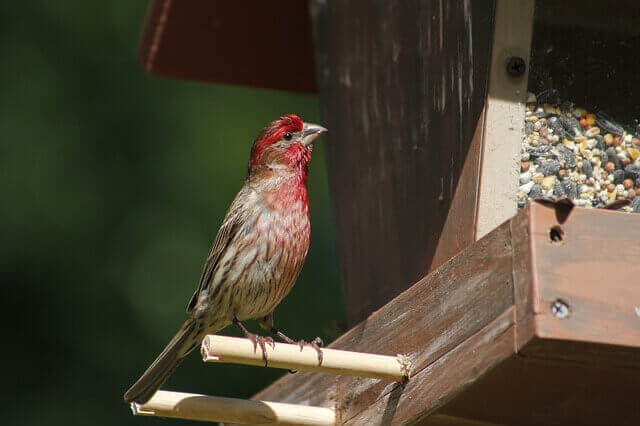
The House Finch is a small songbird native to North America. They live in open habitats such as fields, scrublands, gardens and parks with trees or shrubs. House Finches feed on seeds of weeds and grasses, along with insects they find on plants or while hopping through vegetation.
The House Finch has a long migratory pattern that sees them travel from the northern United States to southern Mexico for wintering purposes, or head northwards during the summer months to breed.
- Frequency: 14.71%
- Color: Reddish face and upper breast, brown streaks on back, belly, and tail.
- Habitat: urban and suburban areas, backyards, edges, yards, and parks
- Range: Canada, USA, Mexico
- Size: 5 – 6″ inches
- Weight: 16 – 27 grams
- Diet: Aphids, grains, seeds, berries, nettle, dandelion, sunflower
- Family: Fringillidae
- Genus: Haemorhous
- Map: Range Map
- Sounds: Calls and Sounds
Related Post: How to Attract House Finch to your Yard
Eastern Kingbird
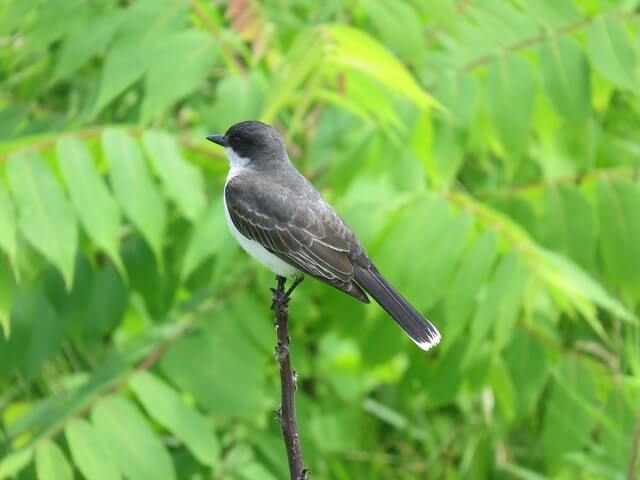
The Eastern Kingbird is a small-sized bird, which can be found in most parts of North America. The Eastern Kingbird is mostly seen during the summer months, but it migrates to warmer climates during winter. The Eastern Kingbird’s range covers most of North America and its habitat ranges from coastal areas, forest edges, wetlands and even urban environments.
Their diet consists mainly of insects such as dragonflies, beetles and caterpillars; they also eat some berries (berries) and seeds (seeds). Eastern Kingbirds will migrate south for the winter, usually staying near Texas or Louisiana during this time period.
- Frequency: 13.84%
- Color: Gray head, neck, breast, gray/brown backs and wings, white underside
- Habitat: Wooded areas, forest edges, roadsides, gardens, parks.
- Range: USA and Canada
- Size: 7.5 – 9.0″ inches long
- Weight: 33 – 55 grams
- Diet: Insects, berries and fruits
- Family: Tyrannidae
- Genus: Tyrannus
- Map: Range Map
- Sounds: Calls and Sounds
Hairy Woodpecker

The Hairy Woodpecker is a North American bird that lives in forests and woodlands. Its range includes the southern parts of Canada, United States, Mexico and Central America. The habitat consists of large deciduous trees, small coniferous trees and shrubs. Woodpeckers are insectivores, so they feed on insects such as ants, termites, crickets or beetles found on tree trunks.
They also eat nuts from pine cones or beechnuts. It has been observed that these birds migrate during colder months from their normal range down into Central America
- Frequency: 13.63%
- Color: Black and white checkered throughout, all white underside, has a mask
- Habitat: Wooded areas, forest edges, roadsides, gardens, parks.
- Range: USA and Canada
- Size: 7.0 – 10″ inches in length
- Weight: 40 – 95 grams
- Diet: Berries, seeds, nuts beetles, ants, caterpillars, and others.
- Family: Tyrannidae
- Genus: Tyrannus
- Map: Range Map
- Sounds: Calls and Sounds
Dark-eyed Junco
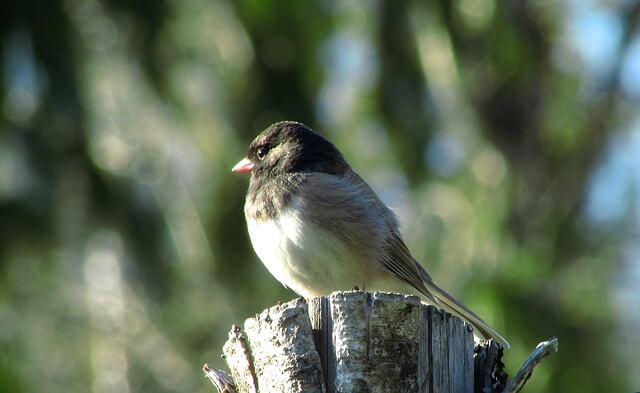
The Dark-eyed Junco is a small, gray-brownish bird that lives in North America. They are fairly common and can be found throughout the United States as well as Canada. The juncos range from the Rocky Mountains to the Eastern Coast of Canada, from California up to Alaska and down to Texas. Juncos typically inhabit areas near water sources such as ponds or streams where they forage for food, which includes insects, earthworms and other invertebrates that live close to the ground.
Juncos eat seeds and other plant parts during the winter months when they are unable to fly south or find shelter; otherwise, they will switch to invertebrates like ants, beetles, caterpillars and spiders.
- Frequency: 13.21%
- Color: Gray head, neck, breast, gray/brown backs and wings, white underside
- Habitat: Wooded areas, forest edges, roadsides, gardens, parks.
- Range: USA and Canada
- Size: 5.1 – 6.9″ inches
- Weight: 18 – 30 grams
- Diet: Seeds, insects, and arthropods
- Family: Passeriformes
- Genus: Junco
- Map: Range Map
- Sounds: Calls and Sounds
Related Post: Interesting Dark-eyed Junco Fun Facts
The backyard bird’s below, have a frequency of less than 13% throughout the year.
- House Wren (12.23% Frequency)
- Cedar Waxwing (12.04% Frequency)
- Yellow-headed Blackbird (12.03% Frequency)
- Horned Lark (11.98% Frequency)
- Tree Swallow (11.90 Frequency)
- Common Yellowthroat (10.88% Frequency)
- Least Flycatcher (10.06% Frequency)
- Eurasian-collared Dove (9.90% Frequency)
- Savannah Sparrow (9.89% Frequency)
- Western Kingbird (9.74% Frequency)
- Yellow-rumped Warbler (9.60% Frequency)
- Gray Catbird (9.28% Frequency)
- Pine Siskin (8.82% Frequency)
- Cliff Swallow (8.15% Frequency)
- Vesper Sparrow (7.84% Frequency)
- Bobolink (7.84% Frequency)

